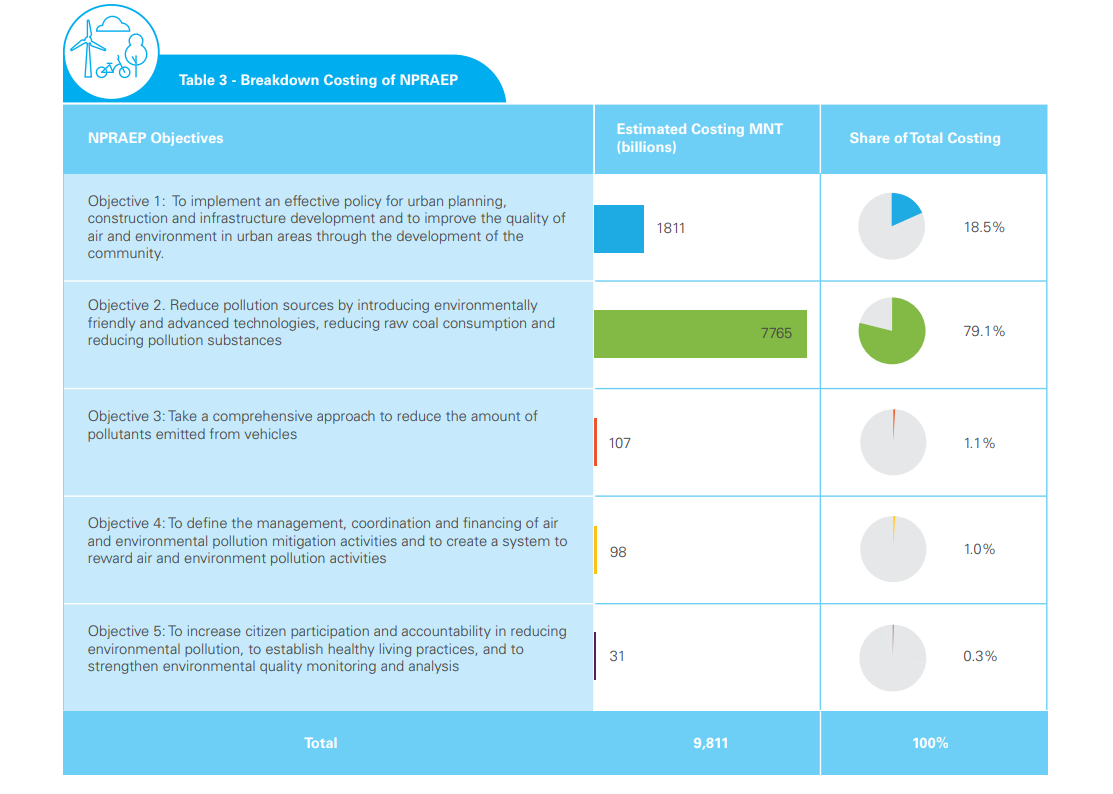Policy and Institutional Response to Air Pollution in Mongolia

Across the political spectrum, there is a recognition that action must be taken to address air pollution. The GoM has responded to this imperative and is committed to addressing the impacts air and environmental pollution have on the country. The GoM’s response is informed by its current institutional and policy framework on the issue of pollution, which include existing strategic documents, frameworks, and sector plans.
Mongolia’s Sustainable Development Vision 2030, approved in 2016 and firmly anchored in the Sustainable Development Goals (SDGs), envisions significant efforts aimed at tackling air pollution and its impact on public health. One goal is the elimination of air pollution in Ulaanbaatar City, specified under Phase I of Objective 2 for Ecosystem balance: ‘... and have no air pollution in Ulaanbaatar City’. This ambitious goal is complemented by a variety of other objectives aimed at ‘reducing factors affecting preventable maternal and child mortality.
Mongolia has also adopted a variety of specific policies, laws, action plans, and strategies aimed at reducing air pollution and its impact on the health of Mongolian citizens. These vary in terms of their mandate, level of prioritisation, competence, as well as area of focus. Table 1 provides an overview of the main laws, policies, programmes, and strategies which have focused on minimising air pollution over the past few years.
Adding to the laws, policies, programmes, and strategies identified in Table 1, there are additional initiatives undertaken by the GoM that aim to mitigate air pollution and its impact on children’s health, specifically, as outlined in Table 2.
Furthermore, this section of the report describes the recently approved NPRAEP, which was created to overcome the shortcomings of previous strategies aimed at reducing air pollution in Mongolia over the past years. The NPRAEP Implementation Plan helps identify the main areas of concern of the GoM, as well as where its efforts will be focusing over the coming eight years.
Table 1. Laws, Policies, Programs and Strategies on Air Pollution Reduction
- Green Development Policy (2014).
- Mongolia’s Contribution to Mitigating Climate Change (2015).
- Government of Mongolia Action Plan for 2016 – 2020.
- Clause 4.1.11 and Provision 10.4 of the Mongolian Law on Development Policy and Planning.
- Clean Air Fund (abolished in 2014). • Provision 14.1 of the Law on Environmental Protection.
- Clause 6.1.1 of the Law on Air (2012), incorporated with Law on Reducing City Air Pollution.
- Recommendation 03703 of the National Security Council.
- Law on Environmental Impact Assessment.
- Law on Air Quality (2012).
- State Great Khural’s New Development ‘Smoke Free Ulaanbaatar’.
- Strategy for Reducing Climate Change, Adapting to Climate Change, and Protecting Public Health (passed by order no. 404, Minister of Health, December 2011).
- National Air Quality Standards of Mongolia were approved by Resolution 67, December 2007.
- National Program on Environmental Health (2005, Govt Resolution 245). • State Policy on Ecology (1997).
Table 2. Additional initiatives on air pollution
- Provision of free electricity to poor households in the ger areas during night time in the winter months
- Distribution of clean stoves and face-masks to poor households.
- Distribution of air-purifiers to schools and hospitals
- Subsidies for parent carers during period of sickness of their child to avoid overcrowding of hospital facilities (introduced for winter of 2016/17).
- Pilot program on introducing 15,000 pneumococcal vaccines for children in two districts (2016).
- Free provision of some medicines during winter months (2016/2017)
NPRAEP
Recognising that ‘earlier efforts to reduce environmental pollution did not reach the desired results’18,19, the GoM recently launched the NPRAEP (2025). This programme is a comprehensive strategy which integrates policies aimed at reducing air and environmental pollution with ‘concrete implementation actions and inter-sectoral coordination using all available technical, financial and human resources20’. The programme is, to a large degree, a successor to the MNT 18.8 billion New Medium-Term Development Programme 2016, which also sought to address air and environment pollution but could not be fully implemented due to lack of secured funding. The NPRAEP, in contrast, is more comprehensive than its predecessor and has thus far managed to garner more political capital. The programme is being led by the Prime Minister within a social context of increased awareness of the problems associated with health pollution, which increases the urgency to act upon this problem.
The NPRAEP was originally costed at MNT 4.9 trillion. However, the recently published implementation plan shows that cost estimations rise to MNT 9.8 trillion over the eightyear implementation period, as listed in Figure 1 below:

The NPRAEP has five main objectives aimed at providing medium- to long-term strategies to address air pollution within Mongolia. The recently published implementation plan for the programme provides an estimation of the budget requirements to address the programme’s objectives, as outlined in Table 3 below.
As can be seen in Table 3, nearly 80% of the estimated cost of implementing the NPRAEP are expected to be spent on Objective 2 (79.1%) – activities aimed at reducing pollution sources by introducing environmentally friendly and advanced technologies. While these activities are crucial to reduce the cost of air pollution, they focus almost exclusively on the energy sector and how to make it more environmentally friendly .
Potential financing sources22 identified by the GoM for the implementation of the NPRAEP include but are not limited to:
- national and local government budgets;
- revenues generated from Air Pollution Fees;
- revenues generated from Water Pollution Fees;
- loans and aid from international organisations and donors; and • private sector financing.
While potential sources of financing have already been identified, only 4.5% of the total estimated cost for the entire eight-year period has been secured (Figure 2). An estimated 2.0% – MNT 200 billion – is expected to be financed by the State Budget. Another 2.5% – MNT 240 billion – will be financed by revenues collected via an Air Pollution Tax.


The NPRAEP focuses extensively on medium- and longterm outcomes which require significant investment, such as refurbishing the ger districts or transforming the energy sector by adopting less polluting alternatives for energy generation. This is an ambitious programme which is being launched amidst an austere economic context marked by increasing debt levels and an International Monetary Fund (IMF) programme which demands the adoption of fiscal austerity measures to reduce public spending. As a result, implementation of the NPRAEP will most likely be a challenging undertaking and will require the involvement of a wide range of stakeholders, including local authorities, MDAs, bilateral and multilateral donors, the private sector, and civil society. The vast majority of MDAs have some responsibility in regard to the implementation of the NPRAEP
This report identified six key government stakeholders involved in mitigating the impact of air pollution on children’s health, directly and indirectly. These are the Ministry of Construction and Urban Development (MoCUD), which is responsible for guiding the conversion of existing homes in the ger districts to ‘green homes’ through the provision of affordable loans; the Ministry of Environment and Tourism (MoET), which is responsible for monitoring the implementation of the NPRAEP and which hosts the Secretariat Committee of the NPRAEP; MoECSS, which has an important role to play in reducing children’s exposure to air pollution by ensuring that schools are a safe environment for children and in delivering public outreach campaigns targeting minors; MoH, which is responsible for taking the necessary measures to ensure that health facilities of all types can deliver services which mitigate the health implications of air pollution; the Social Insurance General Office (SIGO), which is responsible for ensuring that all Mongolian nationals have access to healthcare; and the Capital City Governor’s Office, which can channel some of its resources and human capacity towards mitigating the effects of air pollution on the health of children living in Ulaanbaatar. A more detailed description of the responsibilities of each of these institutions can be found in Annex D and a detailed description of the financing needs of each of them under the NPRAEP Implementation Plan can be found in Annex E.
This report builds on the NPRAEP and estimates the economic losses that will be incurred by the GoM in the provision of healthcare services to children if it does not implement the NPRAEP. The assumptions and estimates guiding the models used by the authors were derived from the NPRAEP






